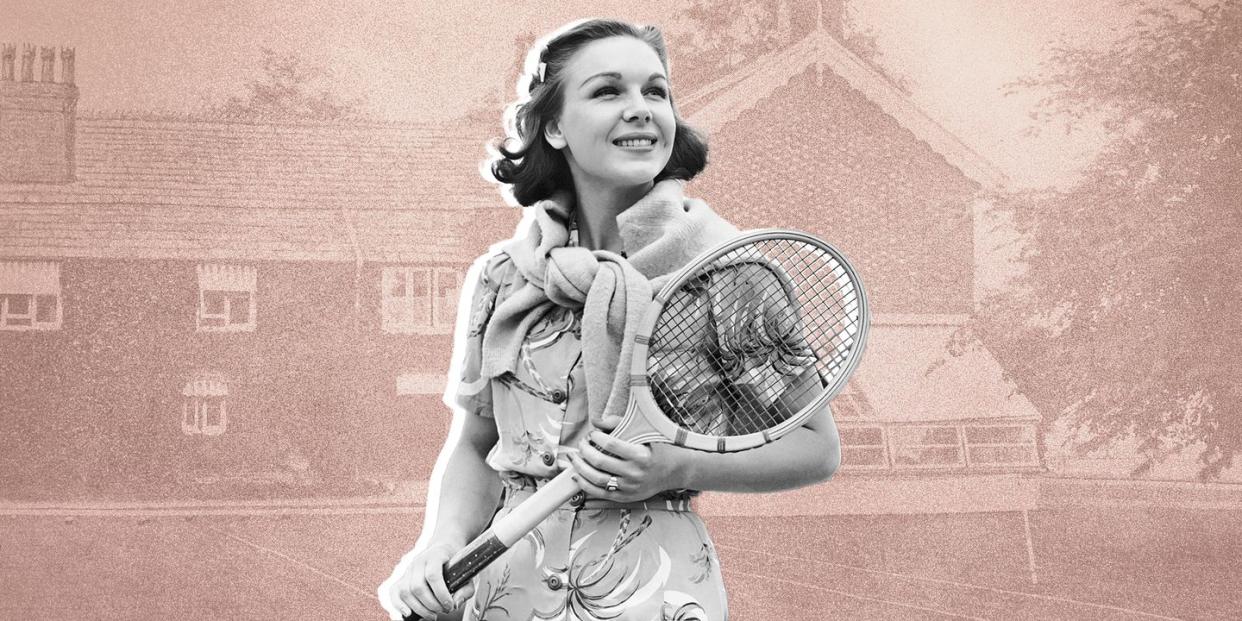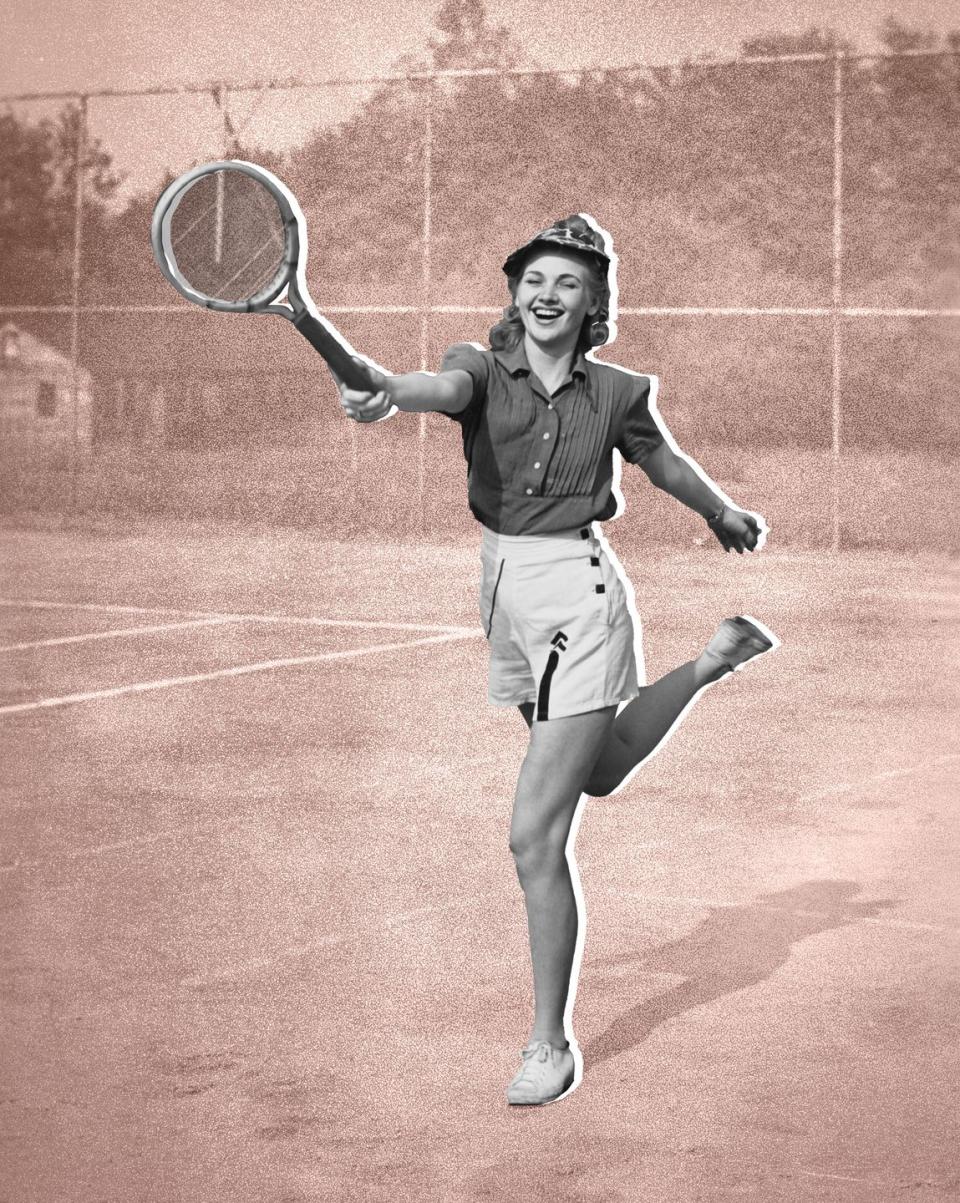Why Has Prep Taken Over the World of Athleisure?

There was a time during the early days of the pandemic where you couldn't look anywhere on social media, let alone on your socially distanced walks, without color-coordinated stretchy ensembles hitting you in the face. But as the world opened up, what we wore changed—not just around the house, but also in our semi-normal day-to-day. It started slowly, with the tennis skirt: a preppy staple, worn both to play the sport and as a fashion statement. And then came the full-blown tennis and pickle ball craze (hobbies that grew quickly during the pandemic). The stylish accoutrements of elite and preppy sports soon trickled down into just about every facet of fashion: Riding boots are back with a vengeance, and golf skirts and tennis sweaters are everywhere.
In a world where micro trends à la Barbiecore and just-about-every-other-core-imaginable explode in popularity seemingly over night, why have we gravitated to prep—and preppy leisure? According to Avery Trufelman of the popular podcast Articles of Interest, (which recently did did a deep dive on American Ivy and preppy fashion), "Prep is a visual language that we understand because we've seen it before." The visual stylings of prep, the activities, the tweeds—they've all existed for over 100 years. "Clothing is a sentence," she explains, "and it's all about people being legible... and we emerged from the pandemic with all of these trends divorced from reality—like clowncore— so of course there was this movement to a heritage trend that is in and of itself trend-less. And some of that comes to preps heritage with sportswear, in its ability to be both comfortable and presentable."

Even on the most casual and leisurely days, clothing is still a statement. So why not lean into a visual that is widely understood—and admired—even for exercise attire? Lest we forget, the polo shirt, a trapping of what many consider a put together, though not all that formal outfit, was originally worn to do just that... play polo. It was the OG athleisure. Of course the 2020's version could evolve into a visual that falls within classic lines—people want to look good, but they also want to be comfortable because the stretchy waistband era of the pandemic will never be fully relinquished.
Naturally, in this space of classic and trend cycle-evading, several brands promising preppy sports attire the roaring 2020s way have cropped up. One such example, Recreational Habits, founded by Jackie Skye Muller and Marlon Muller, touts inclusivity as one of its core values. Their mission, as they put it, is "to bring the exclusive world of preppy elite and their hobbies to the historically excluded." They do this by offering clinics, diverse educational content, and of course their products, with the aim of creating safe opportunities for marginalized communities to experience the benefits of recreational club sports. But if you were to ask Marlon, about what made the revival of tennis—and its related attire—so popular, he'd tell you this: "COVID had a lot to do with the popularity of recreational tennis as a whole. People wanted to be outside and do something new, safely. And the classic silhouettes within tennis have changed very little for the past few decades—the look is solidified itself as an iconic visual of American sportswear, which often inspires ready-to-wear." TLDR: the last few years didn't just revive a visual, it opened it up to more audiences than before. As reported recently by the USTA, between 2019 and 2021 5 million more players picked up a tennis racket, and participation among Hispanic and Latino players climbed 60 percent, while participation among Black players increased 45 percent. There's a whole new group of people participating in the hobby—and it's associated aesthetic.
New brands aren't alone in capitalizing on the craze—so are heritage preppy labels like Lacoste. Back in December, the OG tennis brand partnered with Goop for a collection that reinterpreted its iconic crocodile design. "As a brand with roots in sports and tennis, Lacoste has kept its pioneering spirit, with collections that combine heritage and avant-gardism," explained Catherine Spindler, Deputy CEO of Lacoste. She added, "The limited-edition collection immerses us in a retro universe combining fashion and sport with subtlety. Together, goop and Lacoste explored the heritage styles from the French brand and revisited its archives to find references in detail and form. The two brands have reimagined these traditional styles with new interpretations.” In other words: sleek and stylish and modern updates to the classic tennis and sporting silhouettes you would expect from Lacoste. These revamps appeal thoroughly to the ideal customer of the modern lifestyle brand: the person of means, and in that way the paradigm has not shifted.
While it's that traditional look that carries weight, it's not the only draw. There's also been a massive popularization of the "old money aesthetic" over the last few years. But there's nuance to wanting to look rich on social media platforms. "There's a real opposition to new money a la the billionaires like Musk and Zuckerberg—by comparison old money seems almost quaint and charming and aspirational. The romance in that is safer because it's a fantasy of the past in a lot of ways," says Trufelman.
On the other hand, as Taylor Lorenz reported for the September 2022 issue of T&C, members of the Internet generation aren't unaware of the problematic history behind status totems, which in this case, include the tennis dress. To paraphrase, it's the pose itself that is the act of rebellion in an era when, according to Christina Najjar (who is also known as Tinx on social media), "If TikTok has taught us anything, it’s that anyone can be anything they want with the right Amazon Prime order.: The trend cycle might be embracing the look, but it's not embracing all of the social associations outright.
With new audiences and an undercurrent of ambivalence in the embrace of the aesthetic, what does the trend mean for those who wear it? Claire Stern, Deputy Editor of Elle and lifelong tennis player explains, "The current state of the world has me reveling in comfort and nostalgia at any opportunity—and that includes wearing tennis skirts as regular skirts. I recently acquired a Tory Sport tennis skirt and I plan to wear it often. It makes me feel like a kid again." Notably, Stern's fondness for the look of the sport has nothing to do with the old money ties, "That is an antiquated archetype. With the advent of powerful, strong women like Coco Gauff and Jessica Pegula dominating the sport, following in the footsteps of Serena Williams and Naomi Osaka, the script has flipped."
You Might Also Like

